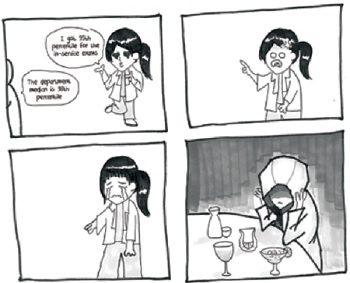How do you hide a $100 bill from a general surgery resident?
You put it at home.
How do you hide a $100 bill from an orthopaedic resident?
You put it in a medical textbook.
How do you hide a $100 bill from a psychiatry resident?
You put it in the middle of the ward and activate code blue.
How do you hide a $100 bill from a forensic pathology trainee?
You put it with a stethoscope.
How do you hide a $100 bill from an OG resident?
Tape it to the patient's head.
How do you hide a $100 bill from an internal medicine resident?
Put it in the patient's dressing.
How do you hide a $100 bill from an ophthalmology resident?
Put it anywhere below the level of the patient's nose.
How do you hide $100 from a plastic surgery resident?
Training/Course fees.

Illustration: Dr Kevin Loy
How did the respiratory senior resident date the anaesthetist?
I see you, ICU?
What do you call an orthopaedic resident and a general surgery resident discussing an electroencephalogram?
A double-blinded study.
What are the ABCDEs of anaesthesia?
A – Airway, B – Breakfast, C– Coffee, D – Dim Sum or Desat (Choy!!!), E – Expedia.com.

Illustration: Dr Justinian Zai
How do you stun an emergency medicine resident?
Ask them what the cultures show and when to give the second dose of antibiotics.
How do you stun a family medicine resident?
Schedule him for a complicated post-operation dressing clinic for the whole week.
How do you stun a paediatric resident?
You give him a $100 bill and tell him to go home. (What are those things???)

Illustration: Dr Tan Yia Swam
What is the difference between an orthopaedic resident and a carpenter?
A carpenter can name three antibiotics.
How should you advise your junior resident when he is supposed to refer to the on-call lady surgical registrar?
"Know your patient's history, examination, findings and management inside out, or you shall be referring yourself shortly."
How do you make a radiology resident sizzle and disappear?
You turn on the lights.
What do you do when your team has a patient with multiple medical and surgical conditions and nobody knows what to do?
Find a low-grade fever and refer to infectious diseases.

Illustration: Dr Tan Yia Swam
Five good friends, all residents from family medicine, psychiatry, general surgery, orthopaedics and pathology specialties, went on a duck hunt. The family medicine resident first spots a duck, hands the rifle to the psychiatry resident and says, "Do you think it's a duck? It has a flat beak and webbed feet. Quick, shoot it!"
The psychiatry resident responds, "To you and me, it looks like a duck. But how do we know that we are not imagining it? Here, have a Prozac, we will feel more confident about it being a duck. Meanwhile let's just admit the duck so it does not hurt itself."
The general surgery resident cannot stand it any longer; he grabs the rifle and fires multiple rounds. He then says to the pathology resident, "So, is it a duck? Make sure it is a duck or better yet, make it a duck! If it's not a duck, then it wasn't me..."
The pathology resident then goes over to the dead duck and says, "This is a beautiful specimen of a mallard. It belongs to the waterfowl family and is a relative of the pintail and the American black. The demise was caused by a single gunshot wound to the neck, which caused a complete transection of the aorta and disruption of the spinal cord and associated vertebral structures. Specimen: Mallard Waterfowl – consistent with duck. Please correlate with clinical, radiology and anthropology findings. The cause of death is 'GUNSHOT WOUND'!"
At this time, the orthopaedic resident emerges from his nap and announces, "Time for beer and Peking duck!"

Illustration: Dr Justinian Zai